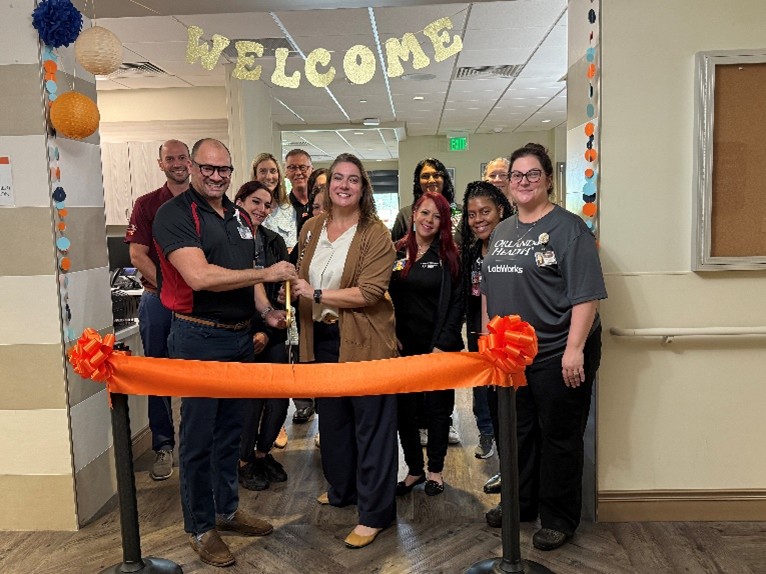Advances in cardiac care improve heart valve disease and reduce stroke risk for patients at Orlando Health Orlando Regional Medical Center
ORLANDO, Fla. (February 18, 2020) --- Two advances in cardiac care are improving heart valve disease and reducing the risk of stroke for patients at Orlando Health Orlando Regional Medical Center (ORMC).
First, younger healthier patients are now able to benefit from a minimally invasive procedure, once only used for high and intermediate risk patients. With the Federal Drug Administration’s approval of transcatheter aortic valve replacement (TAVR) for the newest group, 20,000 more patients per year are eligible for the life-saving procedure. This is in addition to the 60,000 patients previously eligible.
“Recent trials looked at a broader population of patients healthy enough for an open-heart procedure and found TAVR still provides better outcomes,” said Deepak Vivek, MD, interventional cardiologist and director, Orlando Health Heart & Vascular Institute Valve Center. “These results will significantly change how doctors treat patients who have failing aortic valves.”
Second, adding to the new treatment option available to thousands, is a cerebral protection device used during the TAVR procedure to reduce the incidence of stroke.
“Stroke can occur in up to 4 percent of patients treated with TAVR,” said Dr. Vivek. “Using a filter to protect the left and right side of the brain during TAVR has been shown to reduce embolic debris that can naturally break away during the procedure. We are excited to offer this unique cerebral protection device during TAVR our patients. Not every TAVR center offers this protection during the procedure, but we feel that this device offers extra safety for our patients for stroke reduction.”
The Valve Center team places the cerebral protection device at the start of the TAVR procedure via a small tube inserted through a small puncture in the right wrist. A minimally-invasive catheter guides two integrated filters inside the two main arteries between the heart and the brain. The filters collect debris throughout the procedure, thereby preventing it from traveling to the brain. At the completion of the TAVR procedure, the filters and collected debris are removed from the patient.
During the TAVR procedure, cardiologists replace diseased aortic heart valves using a minimally invasive technique, without open-heart surgery and without surgical removal of the diseased valve. The TAVR device is typically inserted through an artery in the leg, and then guided along the arteries into the heart. Once in place, the device expands and takes over the original valve’s function to enable oxygen-rich blood to flow efficiently out of the heart.
TAVR technology began as a generational leap forward for patients who were not able to undergo surgery. Over the years new valve systems continue to advance allowing for smaller incisions, shorter procedure time, fewer days in the hospital and a faster recovery.
Initially, TAVR was used to treat severe aortic stenosis in patients who were at high or extreme risk for surgery. As the national experience with TAVR increased, guidelines expanded to patients considered at intermediate risk for surgery. Today, younger and healthier patients are eligible.
Aortic stenosis is a common heart problem caused by a narrowing of the heart’s aortic valve due to excessive calcium deposited on the valve leaflets. When the valve narrows, it does not open or close properly, making the heart work harder to pump blood throughout the body. Eventually, this causes the heart to weaken and function poorly, which may lead to heart failure and increased risk for sudden cardiac death. Aortic stenosis typically occurs in people over 65 years of age. Untreated, aortic valve stenosis can lead to serious heart problems including heart failure and even death.
Though aortic stenosis is very debilitating and degrades quality of life greatly, TAVR offers a new lease on life – helping patients spend less time in the hospital, more time with family and regain mobility and independence.
The institute’s TAVR Program combines the expertise of various specialists including cardiologists, cardiothoracic surgeons, nurses and other clinicians.
About Orlando Health
Orlando Health is a private, not-for-profit healthcare organization with $5.6 billion of assets under management. The system spans nine Florida counties with nearly 450 locations that include 13 wholly-owned or affiliated hospitals and emergency departments; rehabilitation services, cancer centers, heart institutes, imaging and laboratory services, wound care centers, more than 300 physician offices for adults and pediatrics, and 11 urgent care centers in partnership with CareSpot Urgent Care. In FY18, Orlando Health served approximately 167,000 inpatients, more than 2.7 million outpatients, and more than 20,000 international patients. The organization is home to the area’s only Level One Trauma Centers for adults and pediatrics, and is a statutory teaching hospital system that offers both specialty and community hospitals. Nearly 3,600 physicians have privileges across the system, which is also one of the area’s largest employers with nearly 20,500 employees. Additionally, Orlando Health provides more than $620 million in total value to the community in the form of charity care, community benefit programs and services, community building activities and more. Additional information can be found at www.orlandohealth.com.




